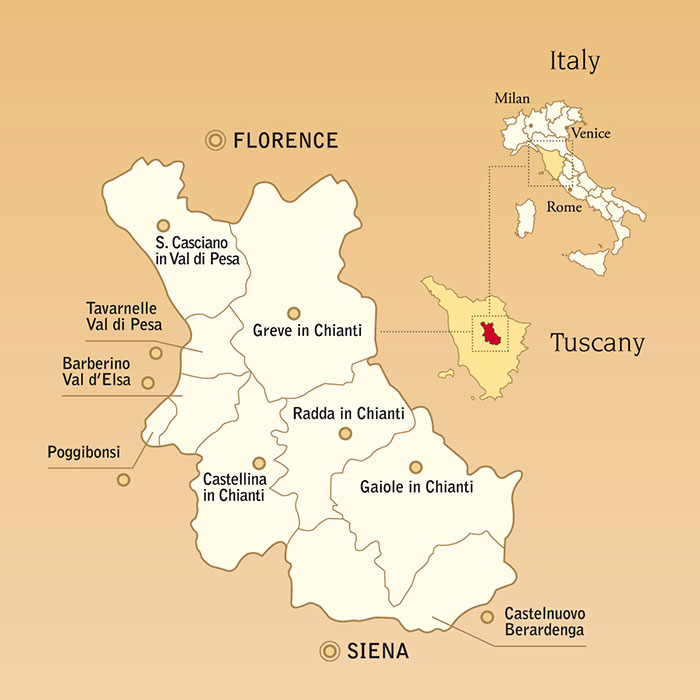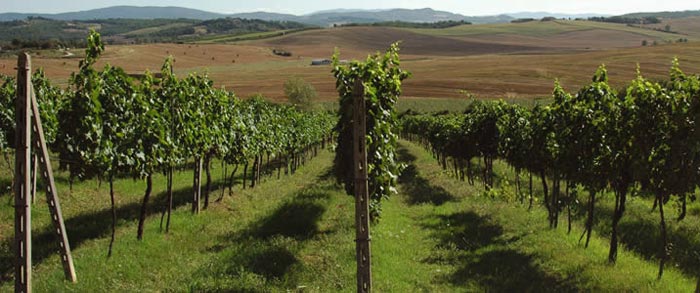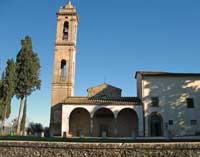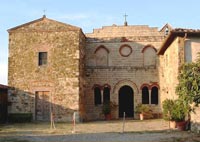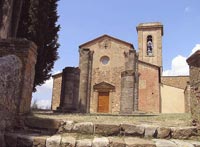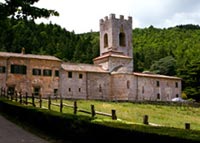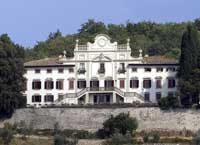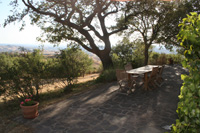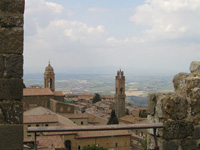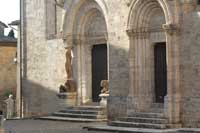| |
|||
Cantina Antinori nel Chianti Classico, loc. Bargino, San Casciano Val di Pesa [1]
|
|||
San Casciano in Val di Pesa
|
|||
San Casciano in Val di Pesa is a comune (municipality) in the Metropolitan City of Florence in the Italian region Tuscany, located about 15 kilometres (9 mi) southwest of Florence.
|
Pieve di San Pancrazio (San Casciano)
|
||
| Wineries |
|||
| Bruscola, Castelli del Grevepesa, Castello di Bibbione, Castello il Palagio, Conti Serristori, Fattoria di Luiano, Fattoria Ispoli, Fattoria la Loggia, Fattoria Poggiopiano, Fattoria San Pancrazio, Fonte al Beccaio, I Tattoli, Il Borghetto, Il Mandorlo, La Sala, La torre di Mezzola, Le Corti, Le Lame, Machiavelli, Massane. |
|||
Tavarnelle Val di Pesa |
|||
| The territory of Tavemelle, like the entire Chianti district, has a particularly rich heritage of rural building: churches, oratories, chapels, villas and farms. In the town itself, of particular interest is the church of Santa Lucia al Borghetto, a rare example of local Gothic architecture. In the immediate vicinity, the interior of the Romanesque parish church of San Pietro in Bossolo contains interesting works of art. The Museo di Arte Sacra has been set up in the clergy house: among the paintings displayed, the most precious is a thirteenth-century panel portraying the Madonna and Child attributed to Meliore. Not far from Tavarnelle, in the Morrocco district, is the Carmelite convent of Santa Maria del Carmine, founded in 1481. Undoubtedly worth a visit is the mediaeval village of San Donato in Poggio. Overlooking the main square are the Renaissance Palazzo Malaspina and the church of Santa Maria della Neve. Not far from the village is the parish church of S. Donato where the interior houses a fine baptismal font in terracotta by Giovanni della Robbia. About a kilometre from the church stands the late Renaissance sanctuary of Santa Maria delle Grazie a Pietracupa, built close to a tabernacle which housed a Madonna believed to be miraculous. The most remarkable complex of the territory is the Badia a Passignano, founded by the monks of the Vallombrosan order in 1049. Set within a stupendous landscape, the Badia a Passignano appears like a fortified hamlet, dominated by a belltower and surrounded by constructions of different periods. The abbey possesses an exceptionally rich archive (almost seven thousand parchments) and precious works of art: the frescoes by Passignano in the church dedicated to San Michele Arcangelo and above all the Last Supper frescoed by Domenico and Davide Ghirlandaio in the refectory of the monastery. Art in Tuscany | Domenice Ghirlandaio, Last Supper frescoes Art in Tuscany | Last Supper Frescoes of Florence |
Tavarnelle Val di Pesa, Pieve di San Pietro in Bossolo
|
||
First fresco on the subject by the Florentine artist, followed by the 1480 version at Ognissanti in Florence and the 1486 versions at San Marco in Florence. The fresco was inspired by the Last Supper painted in 1447 by Andrea del Castagno for the Cenacolo di Sant'Apollonia in Florence.
|
|||
| Wineries |
|||
Casale la Selva, Cerbaia, Col, Coni, Fattoria di Montecchi, Fattoria Morrocco, Frimaio, Il Poggiolino, Le Chiantigiane, Podere la Cappella, Podere La Cappella, Podere Torcilacqua, Poggio al Sole, Poggio Romita, Pratal, San Donato, Sicelle, Tracolle, Villa Montignana. |
|||
Greve in Chianti |
|||
| In the heart of the Chianti Classico is Greve in Chianti, the “wine city”, with its vineyards, olive-trees, its castles, its parishes and its medieval hilltop villages. Greve in Chianti developed predominantly as a market town, with a large market being held in the unusual triangular piazza lined with porticoes, which is still always busy and lively. Among the most important monuments to see in Greve in Chianti we point out here the Chiesa di Santa Croce (Saint Cross Church), the Pieve di San Leolino a Panzano (Saint Leonino Parish in Panzano) and the Pieve di San Cresci (Saint Cresci Parish). Greve is surrounded by delightful villages, such as Montefioralle with its stone houses and paved streets, or Panzano not far from which is the fine Romanesque church of San Leolino. There are also many castles in the surroundings of Greve. Originally defensive bastions they are now elegant residences or famous estates: the Castello di Montefioralle (Castle of Montefioralle), the Castello di Uzzano (Castle of Uzzano), Verrazzano (the name here recalls the famous navigator Giovanni da Verrazzano), the Castello di Vicchiomaggio (Castle of Vicchiomaggio) and Vignamaggio (where Leonardos famous Mona Lisa was born). Of considerable interest in terms of landscape is the Monte San Michele, the highest peak in Chianti (892 m). [read more] |
|||
| The Pieve di San Cresci at Monteficalle is one of five mediaeval parish churches in the comune of Greve in Chianti. Although the original Romanesque building has been altered in later times, the portico and the narthex are still preserved behind the facade with its central doorway flanked by two mullioned windows. As it appears today, the Pieve di San Cresci has a nave without side aisles. Its size has been substantially reduced and it has been deprived of its original termination. The sole Romanesque element of significance, one that is certainly unusual in the Tuscan panorama, is the lower part of the existing facade. In reality, it is the facade of a narthex that served as the porch of the 12th-century church. A portal is inserted in the middle under an arch enclosed by a double course of stone that contains a row of bricks set on point. A double window is placed on either side of the portal and their small columns have simple capitals surmounted by stones cut in a truncated triangular pattern. The arches of these windows are made of terra-cotta and marked by a setback that accentuates the archaic character of the ensemble (from Eurochianti – Arte Romanica tra Italia, Francia e Spagna). [read more] |
|||
| The Pieve di San Leolino, in the neighbourhood of the frazione of Panzano, is probably of 8 C origin and was completely rebuilt in the 12 C in Romanesque style. The interior houses a 13th century panel by Meliore di Jacopo, a 15th century polyptych by the so called Master of Panzano, as well as works by Raffaellino del Garbo and Giovanni della Robbia. |
|||
| Castello di Montefioralle is probably one of the most ancient villages in Chianti. Once the theatre of centuries-old battles between Sena and Florence for the supremacy over central Tuscany, the castle today is still inhabited and preserves intact its medieval townplanning. | |||
| Wineries |
|||
Altiero, Belvedere, Campocort, Camprian, Carobbio, Carpinet, Casaloste, Castel Ruggero, Castellinuzza, Castello di Quercet, Castello di Tizzano, Castello di Uzzano, Castello di Verrazzano, Castello Vicchiomaggio, Cennatoio Inter Vineas, Corte di Valle, Fattoria Casenuove, Fattoria la Presura, Fattoria la Quercia, Fattoria l’Ottavo, Fattoria Montagliari, Fattoria Viticcio, Fontodi, I Fabbri, Il Molino di Grace, Il Palagio, Il Santo, Il Vescovino, La Doccia, La Madonnina, La Marcellina, La Massa, Le Bocce, Le Cinciole, Le Fonti, Le Masse di San Leolino, Monte Bernard, Montefioralle, Panzanello, Pian del Gallo, Pile e Lamole, Poggio Asciutto, Querciabella, Reggine, Renzo Marinai, Rignana, Sagrona, San Cresci, Santo Stefano, Savignola Paolina, Solatio, Sugame, Tenuta di Nozzole, Tenuta di Riseccoli, Tenuta La Novella, Terre di Melazzano, Terreno, Torraccia di Presura, Vecchie Terre di Montefili, VignoleVilla Buonasera, Villa Cafaggio, Villa Calcinaia , Villa Casale, Villa Vignamaggio, Vitiano. |
|||
Castellina in Chianti |
|||
| Castellina in Chianti is a little town of 2800 people in Tuscany's Siena province, some 35km south of Florence and 15km north west of Siena. Lying in the Chianti hills, it is set between the Elsa, Pesa and Arbia rivers. A very ancient town, Etruscan in origin, it became fortified in the Middle Ages. The major sights date from those times, including the massive Rocca (or castle) with its fourteenth century tower. The Rocca has a small Etruscan museum. See too the Palazzo Ugolini-Squarcialupi and the Palazzo Bianciardi, the Via delle Volte underground tunnel and the Poggino necropolis. And the Montecalvario Mound, outside the town, consists of four sixth century BC tombs. Information Offices - Castellina in Chianti | Centro Servizi Turistic | Via Ferruccio 40 |
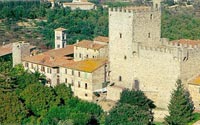 |
||
| Wineries |
|||
Bartali, Belvedere di San Leonino, Borgo di Pietrafitta, Bucciarelli, Buondonno, Caggio, Campalli, Casafrassi, Casale dello Sparviero, Casanuova di Pietrafitta, Casina di Cornia, Castagnoli, Castellare di Castellina, Castello di Fonterutoli, Castello di Rencine, Castello la Leccia, Cecchi, Cennino, Collelungo, Concadoro, Fattoria Castello di Monteriggioni, Fattoria Tregole, Gagliole, Grignanello, Il Poggiolo, Il Villino, La Castellina, La Croce, La Mirandola, La Piaggia, Le Fioraie, Lilliano, Lornano, Montesassi, Nittardi, Piccini, Podere Fioraine, Podere Tramonti, Poggio alla Croce, Poggio Amorelli, Pomona, Querceto di Castellina, Ricudda, Rocca delle Macie, Rocca di Cispiano, Rodano, San Donatino, San Fabiano Calcinaia, San Giorgio alla Piazza, San Leonino, Sant’Agnese, Setriolo, Straccali, Tenuta Canale, Tenuta di Bibbiano, Villa Cerna, Villa Rosa, Villa Trasqua. |
|||
Barberino Val d'Elsa |
|||
| To the south of Tavarnelle, set on a plateau boasting a magnificent panoramic view, stands the town of Barberino Val d`Elsa featuring numerous traces of its mediaeval past. These include extensive stretches of the walls, the entrance gates (that on the south side retains its original fourteenth-century features) and a number of buildings such as the Palazzo Pretorio, with a facade emblazoned with noble coats-of-arms, the Spedale dei Pellegrini (now the premises of the Council library) and the church of S. Bartolomeo rebuilt in neo-Romanesque style in the early twentieth century. | |||
| On the road to Certaldo we come to the remains of the , destroyed by the Florentines in 1202: to commemorate the event, in 1597 the octagonal chapel of San Michele Arcangelo was erected, to a design by Santi di Tito, crowned by a miniature version of the cupola designed by Brunelleschi for the Cathedral of Florence. Just a few kilometres away is the beautiful Romanesque church of San Appiano, a religious centre of enormous importance in the Middle Ages, named after the saint traditionally believed to be the first evangeliser of the Val d`Elsa. Particularly striking are the four cruciform pillars which stand in front of the church, part of the ancient baptistery which was later destroyed. Adjacent to the church is a small Antiquarium containing archaeological material |
Romanesque church of San Appiano |
||
| Wineries |
|||
| Casa Emma, Casa Sola, Castello della Paneretta, Castello di Monsanto, Fattoria la Ripa, Il Campino, Impresa Enoagricola, Isole e Olena, Le Filigare, Quercia al Poggio, Spadaio e Piècorto, Tenuta Bonomonte, Villa Francesca. |
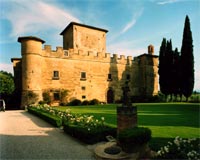 Castello della Paneretta |
||
Castelnuovo Berardenga |
|||
| Information Offices - Castelnuovo Berardenga | Ufficio Turistico Comunale
| Via del Chianti, 61 Weekly market is on Thursdays | Piazza Marconi 8.00-13.00 |
|||
| Parish Church of Santa Maria a Spaltenna |
|||
| Five kilometres from Siena near Castelnuovo Berardenga, on the top of a hill covered in vineyards, stands villa di Geggiano. The actual Villa di Geggiano has a history dating back to the 13th century. It has been owned by the Bianchi Bandinelli family since 1527. There is a richness of historic interest behind the family and the Villa. This goes back to Rolando Bandinelli who became Pope Alexander III and defeated the fearsome German Emperor, Frederick Barbarossa in 1125. More recently, and in World War II, the family was responsible for harbouring Jews and other opponents to the fascist regime. The family seems to have developed a laudable habit of getting the better of the less attractive invaders to their homeland. The Villa di Geggiano is itself of outstanding cultural and artistic interest. In 1780 the interior of the Villa was restored and lavishly redecorated in order to celebrate an important family wedding. Since then, and owing to a modest decline in the family fortunes from their 18th century peak, and owing also to the absence of central heating, these internal decorations of 1780 remain unchanged and in outstanding original condition. [read more] |
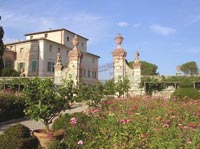 Villa di Geggiano or Villa Bianchi Bandinelli |
||
| Abbadia d'Ombrone and Monastero d'Ombrone near Castelnuovo Berardenga, is an ancient medieval stronghold, dating from the 11th century. The place name Monasterio refers to the nearby church of San Salvatore della Berardenga. Monastero dell’Ombrone was once the home of the noble Chigi Saracini family of Siena. On the villa's left side stands a Romanic imposing bell tower in Lombard style with a squared plan. At the opposite side there is the S. Salvatore Church. |
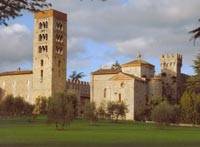 |
||
Gaiole in Chianti |
|||
Gaiole dates back to 1200 when a large market was started up to supply the nearby castles with goods. Via Ricasoli, in the town center, is still the daily location of a lively, picturesque market.
|
|||
| Information Offices - Gaiole in Chianti | Ufficio Informazioni Turistiche | Via G.Galilei 11 Weekly market is on the 2nd Monday of the month |
|||
The castle of Brolio, situated in the center of the area of Chianti, is a very impressive castle. It preserves the ancient keep, the fortifications and the chapel. The wine cellar of the castle is famous all over the world for the celebrated wines of Brolio. |
|||
| Parish Church of Santa Maria a Spaltenna | 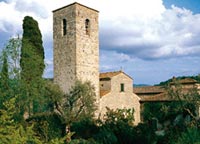 La Pieve di Santa Maria a Spaltenna |
||
| Parish Church of San Giusto in Salcio |
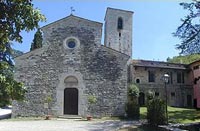 |
||
| Parish Church of San Polo in Rosso |
|||
| Castello di Meleto Perfectly preserved, it is a rare example of a fortified medieval farm, with impressive circular towers, overlooking the surrounding vineyards of Chianti Classico. |
|||
Castello di Cacchiano Badia a Coltibuono |
|||
| Romanesque abbey and cloister, nowadays transformed into wine cellars. Built in between the 10th & 11th century and inhabited by the Vallombrosan Benedictine monks up to the beginning of the 19th century. Badia a Coltibuono has been well-preserved and there are guided tours of the chapel and the italianate garden.
Badia a Coltibuono is located in the Chianti zone of Tuscany near the town of Gaiole in Chianti. This monastery, founded in 1051, was owned by the Vallumbrosan order of Benedictine monks until 1810. In the 15th century, the Buon Raccolto or 'Good harvest' Abbey was extensively developed under the patronage of Lorenzo dei Medici. It was subsequently transformed into a farmhouse-villa, and has retained its agricultural function ever since. |
|||
| Torre di Montegrossi |
|||
| Villa Vistarenni is located between Radda and Gaiole in Chianti near Siena. It dates back to the 18th century and can look back to owners like the Strozzi princes or to the Sonnino barons. Between the towns of Radda and Gaiole in Chianti, two key production centers in the history of Chianti Classico, there extends a large farm of approx. 500 acres, called Fattoria di Vistarenni. The 16th century Villa Vistarenni dominates it from a hilltop 500 m above sea level. The villa, a former property of the Florentine Strozzi Family, and later of the Sonnino Family, which gave birth to some senior officers of state in early Italian governments, now belongs to the Tognana Family. Gardens in Tuscany | Villa Vistarenni |
|||
Radda in Chianti |
|||
| Information Offices - Radda in Chianti | Ufficio Informazioni Pro Loco Piazza del Castello Weekly market on the 4th monday of the month |Piazza IV Novembre 15.00-20.00 |
|||
| Palazzo del Podestà |
|||
| Convento dei Francescani |
|||
Castello di Volpaia Castello di Volpaia overlooks the village of Radda in Chianti. The town was built in the 11th century as a fortified village on the Florence/Siena border. Although only part of the original protective walls and two of its six towers are still standing, the medieval layout and buildings within the village are still intact, making Volpaia one of the best preserved villages of its period. It’s one of the pearls of the Chianti region. The nice thing about Volpaia is that they still use the old buildings for the wine production. While the most factories have built new modern buildings, the Castello di Volpaia still uses the cellars down the church and the olive presses at the other side of the town. |
|||
| Once this belonged to the fortification system of the Albola Castle, but during the centuries it has been transformed into wine factory and villa. The oldest buildings on the estate date from the 12th century, when the property was owned by the noble Magnate of Monterinaldi. It was subsequently owned by families who shaped Tuscan history: the Acciaiuoli, the Samminiati, the Pazzi and the Princes of Ginori Conti. The Zonin family acquired the property in the 1970s. Tte Zonin Family, have 12 wineries. One in Virginia (US) and 11 in Italy (4 in Tuscany). The oldest part of Pian d’Albola dates back from early 12th century, while the real villa has been added around 1725. |
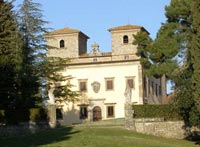 Villa Albola |
||
The Chianti Classico consortium | Via Scopeti, 155 - Sant'Andrea in Percussina - 50026 San Casciano in Val di Pesa (FI) | www.consorziovinochianti.it |
|||
Podere Santa Pia is a fully equipped 4 bedroom holiday home. This classic Italian farmhouse has been superbly renovated and enjoys a magnificent location overlooking the Maremma hills.The surrounding countryside is superbly peaceful with vineyards, olive groves, medieval hamlets and castles. Hidden away from mass-tourism, Santa Pia displays simple sophistication with cotto floors, Tuscan wood beams and an inside pizza oven. The peacefulness of the countryside, the various unique villages and the friendly atmosphere will no doubt pleasantly surprise you. This is the land where the DOC wines Montecucco and Brunello di Montalcino are produced. So, the surrounding countryside is the ideal area for an uncommon wine tour, visiting small farms producing wine and excellent extra virgin olive oil. If you want to spend an unforgettable holiday at Podere Santa Pia and visit these beautiful medieval castles and villages, visit our special offers page or contact us. Holiday accomodation in southern Tuscany | Podere Santa Pia |
||||
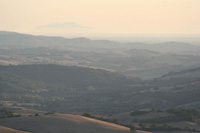 |
||||
Podere Santa Pia |
Podere Santa Pia |
Stunning views |
||
Pienza |
Montalcino |
San Quirico d'Orcia |
||
Podere Santa Pia is situated in the province of Grosseto, few miles from Montalcio and Montet Amiata. It sits upon the highest hill of the landscape in a peacefull position, three miles from the village of Castiglioncello Bandini, in the hearth of the Valle d'Ombrone. "I'm so happy to have been able to keep alive the historical tradition of making olive oil and honey from the fruit of the land at Il Palagio. With 10% of profits going to the environmental charities we support, I feel that we're using nature's bounty to give something back to the earth too, and so help preserve its future for generations to come. And it all tastes great!" - Trudie Styler |
||||
Interactive map of Chianti Classico with subzones and producers.| www.tenzingws.com
[1] Photo by Antonio Cinotti, published under a Attribution-NonCommercial-NoDerivs 2.0 Generic (CC BY-NC-ND 2.0) license. |
||||

